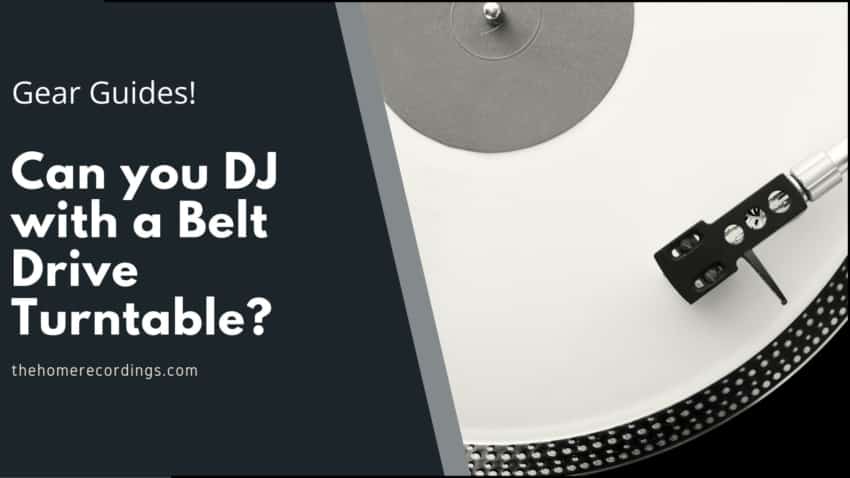If you’re planning to DJ with turntables, you will generally have two choices – belt drive and direct drive. When I first started DJing, I often wondered about the differences between these two types of turntables and whether a belt-driven table was actually a suitable option for DJing – read on to find out what I learned.
So, can you DJ with a belt drive turntable? While it is possible, the low-speed stability of belt drive turntables is going to significantly slow down the platter and reduce precision when DJing, and are much more suited for listening to an LP on a good Hi-Fi system. Direct drive tables provide more power to the platter and therefore have more optimal speed stability to facilitate fast mixing and scratching when DJing.
Belt Drive vs Direct Drive
Before I get into DJing with a belt-drive turntable, let’s take a quick look at the differences between belt drive and direct drive.
Belt-driven turntables are powered by a motor found on the side of the platter, which is connected to a rubber belt. This isolates the motor from the platter, thus reducing motor noise and vibration, but the power delivery is low.
On the other hand, direct drive turntables are powered by a motor located under the platter, resulting in the platter spinning directly along with the motor. This provides optimal speed stability to the platter, but the direct contact with the motor produces a lot of undesirable motor noise and vibration.
What is a Belt Drive turntable?
Belt-driven turntables are forms of turntables that isolate the motor mechanism from the platter itself. The motor drives a belt that turns the turntable and is located on the side of the turntable away from the platter.
The purpose of this design is purely to isolate the mechanism of the motor from the platter itself in order to reduce the amount of motor noise and vibration that will be produced by the turntable.
This makes it an excellent choice for seamless audio quality when listening to LPs on your turntables, but the mechanism design comes at the cost of low speed stability. This essentially means that the power delivery to the platter is low.
As a result, if you pause a record or interrupt it with your fingers on a belt drive turntable, it will take a while for it to return to regular playback speed. This can make it very difficult to make quick and precise mixes and scratches when DJing.
What is a Direct Drive Turntable?
Instead of using a mechanism that is isolated to the side of the hardware, direct-driven turntables use a motor that sits directly under the platter, directly spinning or ‘driving’ it. As a result, direct-drive turntables provide direct power to the platter and this results in excellent speed stability.
Essentially, this means that after being paused or interrupted by your fingers, your record will return to regular playback speed almost instantly. This means that you can rapidly mix, scratch, and chop records with great detail, without having to worry about waiting for the speed to return to normal.
While this is excellent for DJing, these strengths in speed stability are compensated by a much noisier motor, resulting in unwanted vibrations and audible artifacts.
However, I never worry about this too much as whenever I DJ, it’s always in a loud club environment where turntable scratches and audible artifacts are expected.
Which one is better for DJing?
I have always found that direct drive is the superior option for DJing, purely because the speed stability is significantly better than belt-driven turntables. Records return to regular speed rapidly after being interrupted, making it ideal for scratching, mixing, and chopping records.
Which one is better for listening to music?
Whilst I prefer to DJ with direct drive, listening to music is a much more pleasurable experience on belt-driven turntables. This is because the belt drive isolates the motor from the output, resulting in a significantly cleaner sound free from noise and vibrations. The lack of speed stability really doesn’t matter here, as I’m generally listening to records from start to finish.
Do you need a DJ Mixer?
If you are planning on DJing with either belt drive or direct drive turntables, you’re going to need a DJ mixer. A DJ mixer is a hardware module that has multiple inputs (usually RCA connections), allowing you to connect multiple turntables which can then be mixed across two channels.
USB DJ mixers come with internal preamps and should be connected to speakers indirectly through an audio interface, whereas traditional DJ mixers will require an external preamp and must be connected to speakers directly through cables.
I only use a DJ mixer when I am DJing, as there is no mixing required when listening to an LP through a single turntable.
How to connect the turntables to the DJ Mixer
Connecting your turntables to a DJ mixer is really easy. All mixers will have at least four RCA inputs, two for left and two for right (resulting in a stereo signal).
Simply grab two sets of stereo RCA cables and connect the ‘L’ and ‘R’ outputs from each turntable into the subsequent inputs on the mixer.
Conclusion
In my opinion, if you are primarily planning to use turntables for DJing, then direct drive is always a better option. The direct power from the motor will make scratching and mixing records easy, and the record speed will keep up with your movements almost instantaneously.
While belt drive can theoretically also be used to DJ with, the low-speed stability is going to be really difficult to work with, and you will need to have rapid hands and pinpoint precision to mix and scratch records. I must admit that the noise levels are much lower when using belt drive turntables, but if you’re mixing up a loud set in a club, this simply isn’t going to be necessary.
